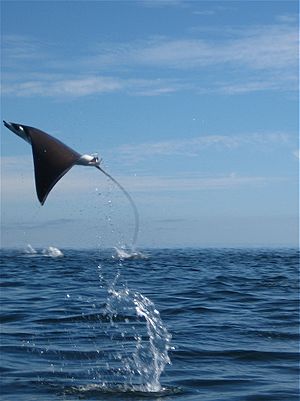Manta de monk facts for kids
Quick facts for kids Manta de monk |
|
|---|---|
 |
|
| Conservation status | |
| Scientific classification | |
| Genus: |
Mobula
|
| Species: |
munkiana
|
Mobula munkiana, also known as the Munk's devil ray or pygmy devil ray, is a type of ray that lives in the ocean. It belongs to the same family as manta rays. You can find these rays in the warm, tropical parts of the eastern Pacific Ocean. Their home stretches from the Gulf of California all the way down to Peru. They also live near islands like the Galapagos, Cocos, and Malpelo. An Italian scientist named Giuseppe Notarbartolo di Sciara first described this ray in 1987. He named it after his teacher, Walter Munk.
Contents
What Does Munk's Devil Ray Look Like?
Munk's devil ray is a large fish with a flat body. Its eyes stick out on the sides of its head. It has gill slits on its underside, which help it breathe. This ray can grow up to about 1.1 meters (3.6 feet) wide. This makes it the smallest type of devil ray.
Body and Fins
On each side of its body, it has wide, pointed pectoral fins. These fins help it swim through the water. Two fleshy parts, called lobes, stick out from the front of its head. These lobes help the ray guide food into its mouth as it swims. Its back fin (dorsal fin) is small. The ray's tail is long and thin, and it does not have a spine.
Coloration
The top of this ray's body is usually lavender-grey to dark purplish-grey. Its underside is white, but it might have a grey tint near the tips of its pectoral fins. The dorsal fin has a dark edge and is often light grey in the middle.
How Munk's Devil Ray Behaves
Munk's devil ray lives in tropical ocean waters, both near the coast and far out at sea. You can find them swimming near the surface or closer to the seabed. They might be alone, in small groups, or in large schools.
Feeding Habits
As the ray swims, water flows into its mouth and out through its gill slits. These gills act like a filter, catching tiny particles of food. They also take in oxygen from the water. Munk's devil rays mainly eat tiny shrimp-like creatures called mysids and other small ocean animals called zooplankton. They also eat small schooling fish.
Amazing Leaps
Munk's devil rays are known for their amazing jumps! They can leap out of the water, either alone or in groups. They perform vertical jumps, somersaults, and other cool acrobatic moves.
Reproduction and Life Cycle
Munk's devil ray gives birth to live young, but not much is known about how they reproduce. The single baby ray first gets its food from an egg yolk inside its mother. Later, it gets food from fluids in the mother's uterus.
Protecting Munk's Devil Ray
The International Union for Conservation of Nature (IUCN) says that Munk's devil ray is a "vulnerable" species. This means it is at risk of becoming endangered.
Threats to the Ray
One reason it's vulnerable is that it doesn't have many babies. Another big problem is that these rays often get caught by accident in fishing nets. They can get tangled in large nets called gillnets. Young rays are also sometimes caught by accident when fishing boats use nets called trawls. They are also more vulnerable when they are close to the shore, especially when they gather in schools. Scientists don't fully understand how these rays move around the ocean. Their travels might be linked to changes in ocean water temperature.


